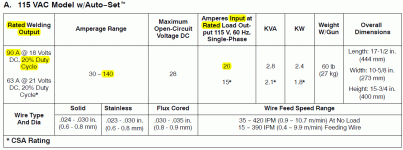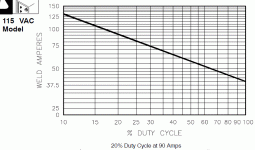Blade Breaker
Gold Member
- Joined
- Mar 12, 2014
- Messages
- 251
- Location
- Southern MN
- Tractor
- 5115M, 825I S.E., 1445 S2, F932, M, H, 8N,
Jim, it would be normal that you would think that. But that would not be the case. To get to the bottom of the matter, you must read the fine print.
Hobart (and Miller and Lincoln etc.) small MIGs give their input rating at their rated output. The rated output is usually the number that looks the most "appealing" for marketing purposes. If you look carefully it states amps input at rated output. Rated output is 90 amps @ 20% duty cycle. Yet, the company states maximum output is at 140 amps. That's a far cry from 90 amps and requires a lot more amps input. The other factor is the relatively new way they state input ratings and that the old way is still allowed. The "preferred" way is to state the I1Max and the I1EFF currents. I am not an electrician and my understanding may not be perfect or accurate in all respects. However, I do try to stay on top of these things. Many welding companies are still using the older way which can muddy the picture somewhat. The I1Max method allows you to properly size breaker, and then the wiring separately. The I1max accounts for the maximum inrush experienced at start up. The I1EFF is the rated effective current draw. Here's a link discussing this for welders:Page 70-537
There are some units we offer and other companies such as Miller offer with inrush ratings of 40 amps or more on 120V for maximum output. They do a good job disguising this, however. They 120V input rating for a Dynasty 200DX is 31 amps (stick operation) @ 100% duty cycle. The machine is rated for up to 200 amps on 120V! Then there is a disclaimer that the units are limited by duty cycle due to input cord sizing. That gets confusing for sure.
To sum it up, no input/output ratings have little to do with what someone might have. The numbers are manipulated by mfgr's in such a way that it makes a person see and think that 140 amps are certainly capable...but then in the fine print show 90 amps output at 20 amps input...and even less on 15 amps input around 70 -75 amps. People think 140, but have no idea they are playing around usually about half that.
Excellent job of explaining this!

